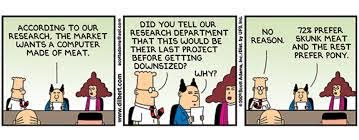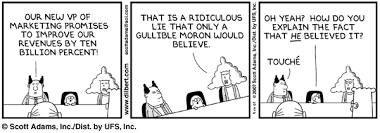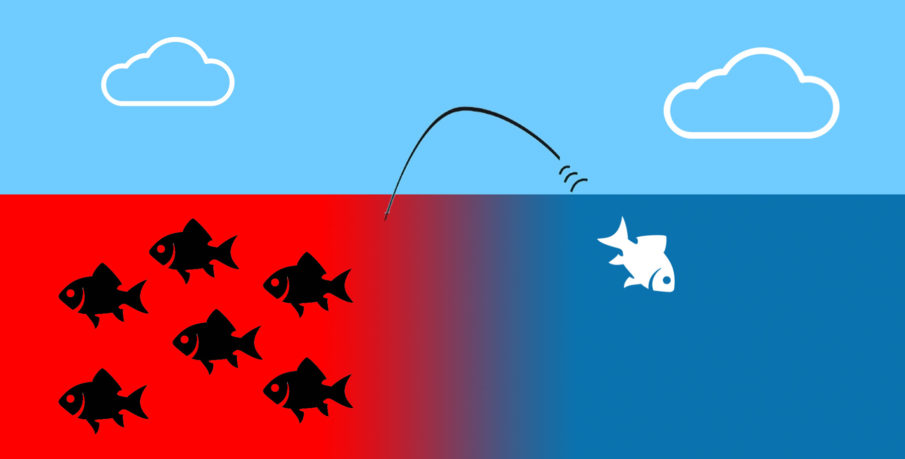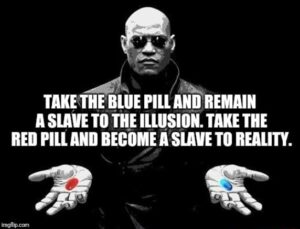Business is no fun but humor is a serious business. Just ask Scott Adams, the creator of the Dilbert comic script. Dilbert teaches us practical business wisdom through humor which no business school can match. Needless to say, humor is the most effective tool to convey an idea that is otherwise difficult to express. So, here’s a fun way to learn the art of swimming in a blue ocean. But first, what exactly is a blue ocean strategy?
Blue Ocean Strategy
Blue Ocean Strategy and Blue Ocean Shift are the best-selling books on business strategy. Written by INSEAD professors W. Chan Kim and Renee Mauborgne, the books provide insight into an alternative path to fast growth by creating a differentiated offering and making the competition irrelevant. This can be achieved either by creating a blue ocean (new untapped & unexplored markets untainted by competition) or making a shift from Red ocean (existing markets with cut-throat competition) to a blue ocean. In other words, it is about expanding the size of the pie instead of fighting for a bigger slice of the existing pie.
Apple is the most cited example of adopting this strategy by becoming a design-driven company instead of a tech-driven company. Then there is the success story of “Chinese Phoenix” Xiaomi also dubbed as “the Apple of China” which is supplying best-in-class but inexpensive smartphones and other tech gadgets with razor-thin profit margins.
Amazon, Uber, Airbnb, Netflix, Spotify are some other examples of tech-based business models which disrupted the respective industries and discovered a blue ocean and that too without creating anything new in terms of products; just a little tweak in the existing business models. Simply put, the journey of getting out of the red ocean and diving into the clearer blue ocean waters is more about reinventing the existing products and services or business models instead of creating an entirely new one.
In the B2B space, Salesforce.com upended the CRM industry and unlocked a blue ocean of non-customers by offering its on-demand CRM software to small and mid-sized firms that had previously rejected CRM enterprise software.
Is tech the magic wand to create a blue ocean? So, it seems, but it is not. Blue ocean is more about value innovation instead of tech innovation. For instance, Motorola’s Iridium satellite phone and Segway’s personal transporter were an engineering marvel but commercial failures because both the products could not offer any value to the buyers.
The blue ocean strategy is also not about making a value-cost trade-off. It is rather about breaking the value-cost trade-off by providing premium value at low-cost.
And finally, blue oceans can be created in any industry. Starbucks, for example, transformed the coffee industry by selling an experience, not a commodity. Similarly, IKEA redefined furniture retail by changing the way we think about furniture. Likewise, Southwest Airlines revolutionized air travel by looking at automobile transportation and not other airlines as their competitive market.
Here is a list of Dilbert rules to identify a blue ocean of untapped opportunities and stand out from the competition.
The Red Ocean Trap
The supreme art of war is to subdue the enemy without fighting. -Sun Tzo
Rule 1: You just can’t beat the competition by working hard.

Rule 2: Niche Marketing is usually not sustainable because of the narrow market segment.

Rule 3: Innovation is not always about creative destruction; there’s also non-destructive creation where old and new can exist simultaneously.

Rule 4: It is much easier to vilify or defame the competition instead of making it irrelevant. Any accusations against your competitors are fine so long as it harms them. As someone said, “a lie gets halfway around the world before the truth has a chance to gets its pants on.”

The shift towards the Blue Ocean: Expanding the Mindset
If I’d ask customers what they wanted, they would have told me a faster horse. -Henry Ford
Rule 5: Wake up and take a hard look at yourself. Face the marketplace reality and comprehend the sheer vastness of the shark-infested red ocean.

Rule 6: Never rely on market research because people don’t know what they want until it is shown to them, so simply go by the gut feel.

Rule 7: Adopt a blue ocean mindset and tap into the blue ocean of unexploited talent and energy.

Rule 8: Put together the right team to carry out the blue ocean initiative.

Rule 9: Don’t forget execution; for overcoming the organizational hurdles in the effective execution, tipping point leadership is required.

Discovering an Ocean of Non-Customers
Marketing is about telling one story in a thousand different magical ways, and here’s that story: Your life could be better, and once you buy what we’re offering, it will be better. The end. -Buster Guru
Rule 10: Connection with the audience requires a good grasp over marketing lingo.

Rule 11: In the age of the fickle consumer, brand loyalty is dead; the way out is to create addiction

Rule 12: Move beyond the trap of making things better for the existing customers; explicit focus on converting non-customers into customers is required.

Rule 13: Reposition your proposition to cater to an impatient digital audience, but for ranking higher in the SERP and getting organic traffic, the only option is to employ SEO dirty tricks.

Rule 14: Social media is here to stay: Hate it, but just can’t ignore it. Why not leverage it?

Rule 15: Sales Engineers need to be taught some practical soft skills

Rule 16: Over-pampering spoils the customers and increases the expectation gap

Lost in the Blue Ocean: The Survival Plan B, C, And D
One of the hardest truths for any technologist to hear is that success or failure in business is rarely determined by the quality of technology. -Dean Kamen
Rule 17: Public Relations is always there for putting out fires

Rule 18: Right and wrong is just a matter of perception.

Rule 19: Data is the new gold: if nothing works out, you can always sell the customers data

Rule 20: If you can’t make it, just fake it!

Rule 21: Finally, if all else fails, just face the ugly truth.

In a nutshell, blue ocean thinking is nothing but lateral thinking in a business setting. It’s about reframing the problems and coming up with better solutions.
Here’s another blue ocean idea. Why can’t learning be unstructured and fun? Any takers for flipping the education sector upside down?
Also Read:





